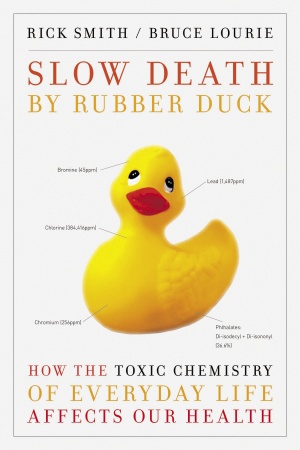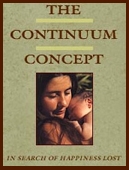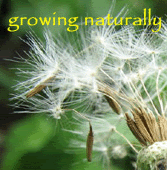What was made clearer to me when I finished reading this book is how complex our pollution problems are. The important issues around the health of our environment aren’t just global warming, air and water quality or… We need to be more aware of the chemical pollution in our everyday lives. There are many toxic chemicals of which we unknowingly bring into our homes and many times straight into the mouths of our little ones.
Rick Smith and Bruce Lourie get up close and personal with six types of man made chemicals (and mercury) that are slowly killing us. These chemicals are in the food that we eat and the products we buy, sometimes without our knowledge and sometimes with the mistaken belief that the damaging chemicals are actually a product feature. A graphic example of this in the book is that “by the time the average woman grabs her morning coffee, she has applied 126 different chemicals in 12 different products to her face, body and hair.” A woman may see a product featuring it’s ability to penetrate deeper into the skin and it’s likely she’ll never ask how it does this or why this could be a very bad idea.
Being a parent and learning more about how many children’s toys are made with toxic chemicals is very disturbing. We can’t rest easy even with newer laws in place to keep especially dangerous chemicals out of toys for children 3 and under. Those especially dangerous chemicals are still usually in toys labelled for children older than 3 and it’s almost guaranteed that they are in hand-me-down toys made before the laws came into being. Let’s not forget that toy manufacturers don’t simply take out these toxic chemicals from toys rated for under 3. They replace them with other chemicals that may or may not be quite as harmful as the ones removed. It’s no wonder that many of the chemicals talked about in this book are actually showing up in higher levels in children than in adults, because children often handle so many plastic and vinyl toys in their hands and in their mouths and with little regard to the age the particular plaything is rated to.
I remember a number of years ago reading about the dangers of teflon. What had I read about freaked me the hell out! Our non stick pans were immediately taken out of use. Over the years I’ve wondered about how teflon could still be in most people kitchens and homes as non stick pans, sometimes lining the oven, on irons…. This chemical is dangerous and has caused illness, birth defects and death. Scary stuff. Bruce heads to “Teflon Town” in West Virginia to look at the destruction it has caused over the years and the many lawsuits and settlements with the company DuPont. A recurring theme in this book is how chemical manufacturers knowingly make dangerous chemicals, try and hide the fact that they are killing people (slowly and painfully or quickly) and even try to find more markets to put their chemical products into.
This is especially noticeable nowadays when you see products of all kinds that are “germ resistant”. Clothing, soap, cutting boards, sheets, steering wheels… all with antimicrobial chemicals weaved into the very fabric of their making. These germaphobic chemicals are unneeded and often ineffective, being absorbed into our bodies to cause known and unknown harm and also contributing to the problem of germ resistantancy or creating “superbugs”.
This book was validating to many of the choices we make in keeping our lives simpler but shocking also to realise that we’re still far from chemical free. We refuse to buy or own (and play with when we can) toys that are plastic and filled with phthalates (tha-lates), keep plastics to a minimum in general, choose organic foods over pesticide ridden alternatives, shop for furniture that is flame retardant free (“Ikea has moved away from all halogenated flame retardants”), refuse to buy or use products that are antimicrobial… and yet there are still often flame retardants in electronics, which are often built with plastics and other chemicals, high gloss “carbonless” receipt paper is very high in BPA, the epoxy lining in tin cans (especially highly acidic tomatoes) are also a source of BPA and on and on. All we can do is be informed and minimise these products in our lives as much as possible.
The last chapter of this book touches on detox and how you can avoid or minimise the use of many of these chemicals. I highly recommend checking this book out.




Thanks Annie, I’m going to check out if my local library has the book!
Annie, thanks so much for the recommendation. I will definitely look into this book.
I too feel like we make a huge effort to avoid so many of the chemical laden products out there (and as someone who doesn’t wear make up or use much in the way of hair products (just almond oil) I’m appalled at the amount of stuff woman use to beautify themselves. Yikes.) Still, I look around my house and know we can do better, or I panic about all that we don’t even know about. It’s so scary.
Your review was great; very well articulated. Thanks so much for caring. xo
This is spot on Annie. I have been paying even more attention to plastic lately. We try hard to aviod it and still it makes it’s way into our home.
We were just reading about Marie Curie today (Fionna is studying famous scientist). It is amazing that during her time companies put radium in everything from face cream to wool. Crazy!!!
We made gum the other day and now I am on a mission to find “natural” gum making ingredients.
Thanks for the recommendation. I will check this out.
Have you read “A Reasonable Life” by Ferenc Mate… you would like it.
Thanks! I really enjoyed this book and I thought it would interest all my like minded readers and friends!
It’s almost impossible to be able to rid our lives of all these chemicals but it’s so worth being informed so we can at least do what we can. When we know better, we do better, right?
Dawn- Thanks for the book recommendation, I’ll check that book out!
I think I talked to you about this book a couple of years ago – I read about it in a local Victoria paper. Although I think I’m doing well, I know I’m not, and it’s mostly ignorance!
It is truly scary how much we (as consumers) just don’t know.
I do turn a blind eye to the occasional thing (food colouring in candies when we’re out, for example) but am trying to stamp toxic things out in my home.
Can I go first on your ‘loan’ list to borrow this book please? Unless it’s from the library…
I’m just heading upstairs in my Mum’s house now to get the box of hand-me-down toys and dispose of them first thing in the morning!
Jo- We are very lucky that our library has two copies! I’ll be returning mine this week. See you soon!
Hi Annie, this was a nice article you wrote and I appreciate your reminder of this kind of stuff. It’s why we went to dried (rather than canned) beans years ago and why so much of our stuff is of glass, metal or wood. Even so, there’s still way too much stuff to avoid drives me nuts. Take our current suite with plastic cupboards for instance!
One thing I’ve noticed recently is that in the push for energy efficiency, so many people are upgrading windows and putting in PVC. Now they’ve got a more air tight envelope… guess where all the toxins are off gassing to?! No thanks! The price differences between PVC and something good are staggering but that seems to be the case for so many of things. Lower prices aren’t indicative of the long term health effects – to us humans or the environment as a whole.
As a society we’ve become such mindless consumers, so disconnected from where things come from, it’s no wonder companies have been able to keep feeding us their garbage… I’m looking forward to the hopeful light that last chapter should give to our situation!
Thanks for the review of this book, Annie. I’ve seen it about, but not bought it or read it yet. It’s on my look-for list again, now!
I am realizing too, that we have far to go to get to where my ideal place would be and my ideal relationship/dependancy on plastic. It was when I was first pregnant and looking at my health, and my babe’s health that I began to have the epiphonies. We all come to awareness in our own unique ways and means and mine accelerated during pregnanacy. I quit buying fast food (my kids have still not eaten fast food..truly!), and turned my attention towards plastics too. We began with eliminating the teflon and phthalates and got ’em out. Then we began replacing all of our plastic dishes/food storage with alternatives. I still have glass with plastic lids. Not perfected yet. Never cook in them or put hot food in them. I still find myself buying salad in plastic (yuck!) because I need the green energy and try to reuse them for gardening, seeds, freezing berries etc. We still love Lego and Playmobil and have a house full of these daily used toys. They will stay. My kids don’t mouth them, and when they were smaller, we had far less plastic. We have some synthetic clothing (fleece, running gear etc) and our tent is synthetic. So is the upholstery in the van I drive every day. We keep our heat low and keep windows open always, and wear layers. I think this really helps with mental clarity and circulating toxins outside of our breathing spaces. It is such a balance, yet I yearn to make changes on a gradual and forgiving basis. I need to be gentle with myself, not compare my “progress” with anyone else’s and continue to be inspired to make change. This book sounds like a read for me that I am ready for this year. I have the energy (finally) to focus on healing ourselves more fully, and helping our mother earth.
I am looking forward to watching the film “Addicted to Plastic” this week from the library. Have you heard of it? A selfdesign mama recommended it awhile back and I’m getting around to it now. Maybe I’ll blog about it, once the boys and I have watched it…there’s a trailer for it on youtube or at Greendog Films website, if you’re curious…
~Erin xo
* That film is at Bullfrog Films…ooops! Here is the link..http://www.bullfrogfilms.com/catalog/atp.html
You’ve grabbed my interest with this review: I think this will be the next book I read, even if I’m a little fearful of what I might learn.
I love that this is an issue many are thinking about!
Erin- I just watched the trailer to Addicted to Plastic. Looks really intriguing! I’m definitely going to watch it!